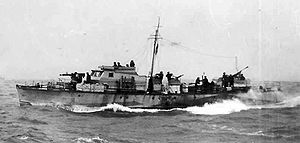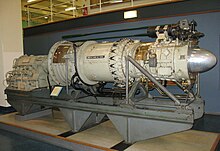Motor Gun Boat

MGB 314 during World War II
Motor Gun Boat (MGB) was a Royal Navy term for a small military vessel of the Second World War. Such boats were physically similar to Motor Torpedo Boats (MTBs), equipped instead with a mix of guns instead of torpedoes. Their small size and high speed made them difficult targets for E-boats or torpedo bombers, but they were particularly vulnerable to mines[citation needed] and heavy weather. The large number of guns meant the crew was relatively large, numbering as high as thirty men.
Contents
1 Description
2 Service
3 Types
4 Survivors
5 See also
6 References
6.1 Bibliography
7 External links
Description
MGBs were extremely heavily armed for vessels of their size. By 1945, MGB 658 carried two power-mounted QF 6-pounders in the A and Y turret positions, a twin 20 mm Oerlikon cannon in the X turret position, a single 20 mm Oerlikon on either side forward of the bridge and two twin .303 Vickers machine guns on the bridge wings. They were also equipped with smoke-making equipment, basic radar and depth charges.
Service

MGB 66 at speed with the crew at action stations, off the coast of Scotland
In the early years of the war, they saw action defending shipping against enemy torpedo boats such as the German E-boats on the southern and eastern coasts of the UK. MGBs were also involved in the protection of shipping after D-Day.
In the Mediterranean, they were used offensively to sink Italian and German shipping. They were formed into flotillas which often operated alongside Motor Torpedo Boats (or US PT boats)[1] and helped interdict supplies being sent from Italy to North Africa in 1943. After this campaign, they moved northwards and assisted with the invasion of Sicily, Sardinia, Corsica and Elba. From island bases they patrolled along the western coast of Italy attacking small coastal ships and E-boats until mid-1944. As Italy was progressively liberated, certain flotillas, such as the 56th, were sent around to the Adriatic to assist partisans in the islands off Yugoslavia.
They did not take the prefix HMS as they were only boats and instead used the prefix "HMMGB" on formal occasions. The crews generally referred to them by their numbers.
In 1947, MGB 2009 was fitted with a Metrovick gas turbine, thereby becoming the world's first gas turbine powered naval vessel.
Types

The gas turbine from MGB 2009 (formerly MGB 509)
Camper and Nicholsons MGB
Pennants: MGB 502 to MGB 509
- Length: 117 ft 0 in (35.66 m)
- Beam: 20 ft 3 in (6.17 m)
- Draught: 4 ft 1 in (1.24 m)
- Displacement: 95 tons
- Propulsion: 3 × Paxman VRB diesel engines
- Total power output: 3,000 bhp
- Speed:
- Maximum: 28 knots (52 km/h)
- Continuous: 25 knots (46 km/h)
- Complement: 21
- Endurance: 2,000 nautical miles (4,000 km) at 11 knots (20 km/h)
Note: MGB 509 was powered by three Packard supercharged petrol engines giving a total output of 4,050 bhp (3,020 kW) and a maximum speed of 31 knots (27 knots continuous). Later re-numbered MGB 2009, this boat was fitted with a Metrovick gas turbine engine in 1947.
Fairmile C motor gun boats were 110 ft (34 m) long boats. The succeeding Fairmile D design could be fitted out either as MGB or MTB.
Survivors
The only fully restored and operational example of a Royal Navy Coastal Forces MGB which saw active service in WW2 is MGB-81.[2] She was built by British Power Boat Co Ltd. Hythe, launched in 1942, and served at the Normandy landings. She is now at Portsmouth.[3]

MGB-81 in Beaulieu River
See also
- Motor Launch
- Harbour Defence Motor Launch
- Fairmile C Motor Gun Boat
- Steam Gun Boat
- Motor Torpedo Boat
- Coastal Forces of the Royal Navy
- Type Two 63 ft HSL
Robert Peverell Hichens, renowned MGB Flotilla commander
Guy Hamilton, film director who served on MGB's during the war.
References
^ Captain Robert J. Bulkley, Jr "Part VI The Mediterranean -- Torpedo War" At Close Quarters PT Boats in the United States Navy Naval History Division, Washington: 1962
^ Coastal Motorboat Heritage Trust, "MGB81", Coastal Motorboat Heritage Trust. Retrieved 30 January 2017.
^ National Historic Ships UK, "MGB 81", National Historic Ships UK. Retrieved 30 January 2017.
Bibliography
Motor Gunboat 658 LC Reynolds (Cassell Military Paperbacks, London, 2002) .mw-parser-output cite.citation{font-style:inherit}.mw-parser-output .citation q{quotes:"""""""'""'"}.mw-parser-output .citation .cs1-lock-free a{background:url("//upload.wikimedia.org/wikipedia/commons/thumb/6/65/Lock-green.svg/9px-Lock-green.svg.png")no-repeat;background-position:right .1em center}.mw-parser-output .citation .cs1-lock-limited a,.mw-parser-output .citation .cs1-lock-registration a{background:url("//upload.wikimedia.org/wikipedia/commons/thumb/d/d6/Lock-gray-alt-2.svg/9px-Lock-gray-alt-2.svg.png")no-repeat;background-position:right .1em center}.mw-parser-output .citation .cs1-lock-subscription a{background:url("//upload.wikimedia.org/wikipedia/commons/thumb/a/aa/Lock-red-alt-2.svg/9px-Lock-red-alt-2.svg.png")no-repeat;background-position:right .1em center}.mw-parser-output .cs1-subscription,.mw-parser-output .cs1-registration{color:#555}.mw-parser-output .cs1-subscription span,.mw-parser-output .cs1-registration span{border-bottom:1px dotted;cursor:help}.mw-parser-output .cs1-ws-icon a{background:url("//upload.wikimedia.org/wikipedia/commons/thumb/4/4c/Wikisource-logo.svg/12px-Wikisource-logo.svg.png")no-repeat;background-position:right .1em center}.mw-parser-output code.cs1-code{color:inherit;background:inherit;border:inherit;padding:inherit}.mw-parser-output .cs1-hidden-error{display:none;font-size:100%}.mw-parser-output .cs1-visible-error{font-size:100%}.mw-parser-output .cs1-maint{display:none;color:#33aa33;margin-left:0.3em}.mw-parser-output .cs1-subscription,.mw-parser-output .cs1-registration,.mw-parser-output .cs1-format{font-size:95%}.mw-parser-output .cs1-kern-left,.mw-parser-output .cs1-kern-wl-left{padding-left:0.2em}.mw-parser-output .cs1-kern-right,.mw-parser-output .cs1-kern-wl-right{padding-right:0.2em}
ISBN 0-304-36183-6
External links
- British Military Powerboat Trust
- Whaleback MGB